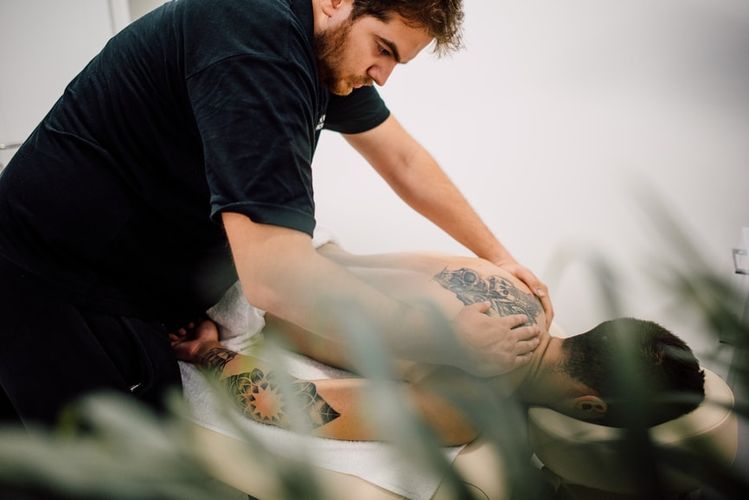Rolfing is an effective way to deal with chronic stress and pain. Rolfing can help break up tension in the body, particularly in the back, that may be contributing to chronic pain problems or stress-related health conditions. Athletes, actors, and physically active people also use Rolfing to improve performance, as Rolfing can help the body work more efficiently.
The Rolf Institute for Structural Integration also teaches that Rolfing can help people develop a more positive, loving relationship with their bodies, and can potentially provide emotional and cognitive as well as physical health benefits. Indeed, while Rolfing is primarily a physical healing technique, the broader goal of the practice is to integrate and heal the patient on many levels - mind, body and spirit.
"Ida Rolf developed the technique as a whole body approach, with the idea that when the body is balanced in a field of gravity it begins synergistically improving," says long-time Rolfer Chris Key, PhD. "If your head is too far forward, if you have scoliosis or excessive stress, tension or anxiety, this will manifest in your body, impacting and constraining your endocrine and nervous systems, for example. Rolfing cultivates a more balanced, symmetrical, open body, leading to improved functioning and better health."
How does rolfing work?
A Rolfing practitioner uses specific, hands-on manipulations of the fascia tissue to release tension and improve the overall alignment, structure and performance of the body. Patients often receive treatment for a period of ten sessions, during which time the Rolfing practitioner works with different areas of the body in sequence. The overall goal is to get the body into what some practitioners call grace, or a state in which all the parts of the body are properly lined up, are coordinated, and contribute appropriately to movement and balance.
The superficial fascia covers the entire body like a leotard. The deep fascia covers and permeates individual muscles. It also covers tendons, ligaments, organs of the body as well as bones. If you viewed only a body's fascial network, you would see a lace-like image of the individual. A Rolfing practitioner manipulates the fascia to release tension and the places where the fascia is "stuck" to ensure that it "fits" in a way that allows the body to be properly aligned within the field of gravity.
Imagine that the fabric of the leotard is bunched, puckered, or gathered in several places so that it doesn't fit correctly and the individual is unable to move freely. The Rolfer works to smooth and unbind the leotard/facia so that it fits better. Movement becomes more effortless and less constrained.
History and philosophy
Rolfing was developed in the 20th century by Dr. Ida Rolf. After earning her doctorate in biochemistry in 1920, Dr. Rolf focused her research on medicine and healing, especially those practices that dealt with the mechanics of the human body. Dr. Rolf realized that the field of gravity is the fundamental medium in which all physical structures, including the human body, exist; and that it is vital that the physical structure of our bodies be properly aligned in order to cope with the constant pull and strain gravity exerts.
Dr. Rolf saw a clear connection between aligning and balancing the body within the field of gravity, and our overall health, since all systems of the body (digestive, respiratory, endocrine, circulatory, etc.) are affected by the body's structure.
Dr. Rolf described her life's work as attempting to answer the question of what the body needs to thrive. Her research into healing practices ranging from yoga to chiropractic and osteopathic manipulative therapy helped shape her holistic view of health and wellness. Dr. Rolf's insights led her to create a process for manipulating the fascia in order to treat injury and promote overall wellness.
Education is also a key part of Rolfing. Rolfing practitioners seek to help their patients learn about and become more aware of their bodies. One goal of Rolfing is to encourage patients to practice working with their bodies, instead of ignoring them or seeing them as obstacles to be overcome.
The difference between Rolfing and massage
Rolfing practitioners delineate clear differences between Rolfing and massage. While both help break down tension in the body, the ultimate goal of Rolfing is integration, or balancing the various systems of the body to support optimal wellness. Rolfing is sometimes more intense in the moment in order to achieve a structural shift that cultivates increased long term wellbeing. Dr. Rolf is quoted as saying "it is easy to take a body apart, but it takes skill and understanding to put it back together." In other words, Rolfers see their practice as taking massage one step further, by building the the body back up after breaking it down.
Science
As a relatively new technique, Rolfing is still in the early stages of comprehensive scientific study. Indeed, given that some Rolfing practitioners see the practice as having goals that are ultimately more spiritual than physical, science may not be the best vehicle for exploring Rolfing's benefits. From a mechanical, physiological perspective, however, Rolfing is believed to work by stimulating the fascia tissue in a way that induces the central nervous system to reset and relax.
A number of studies have found Rolfing to be effective in working with a range of health conditions, including back pain, fibromyalgia, stress, and chronic fatigue, although these have typically been small and limited in scope. One review of the available research noted that Rolfing decreased pain levels, improved physical function, gait, balance and range of motion, as well as increased overall well-being in patients.
Method
How is Rolfing actually practiced? A patient typically lies down on a table, while the Rolfing practitioner uses hands-on manipulations of the fascia tissue to release tension and improve the overall alignment, structure and performance of the body. Dr. Rolf developed a ten-session series of one-hour sessions clients receive over several weeks or months. Each session builds on and reinforces the previous session by addressing different areas of the body, or the same areas in different ways.
Rolfing techniques involve using different parts of the practitioner's hands and arms to manipulate the fascia, including fingertips, palms, knuckles, forearms, and elbows. While superficially similar to other forms of bodywork, practitioners frequently apply pressure to a specific area for longer periods of time than chiropractors or osteopaths, while using more pressure than massage therapists typically do.
The overall goal is to get the body into what some practitioners call a physical state of grace, in which all part of the body are better aligned, and movement is more effortless, coordinated and balanced.
What can rolfing treat?
Rolfing can be an effective treatment for many conditions that have to do with the structure of the body, stress or tension, including:
Chronic pain
Rolfing is perhaps most well-known as a treatment for chronic pain, including back and neck pain. Numerous studies have found Rolfing to be effective at relieving chronic pain. One review of the available research published in the journal Orthopaedic Physical Therapy Clinics of North America suggested this may be because Rolfing relieves pressure by realigning the structure of the body, increasing the flexibility of scar tissue, and increases the flow of interstitial fluid, the fluid that surrounds all of our cells.
Impaired movement
For people with difficulty moving as the result of an injury, trauma or any other health condition, Rolfing can be an effective way to improve mobility. It is suggested that the way Rolfing breaks up tension and improves the pliability of the fascia can help make movement easier. However, the exact mechanism is not fully understood.
Posture
People with poor posture often see improvement after a Rolfing session. This is likely because a goal of Rolfing is to correctly align the structure of the body, and poor posture is often the result of misalignment. Dr. Rolf also suggested that an increased awareness of your body, another goal of Rolfing, helped patients to maintain a better posture.
Stress
Most Rolfing patients report an increased feeling of relaxation after a treatment session. While these feelings tend to be strongest in the short-term, research indicates some patients find that they experienced more lasting upticks in overall feelings of calm and well-being. As with most treatments, longer-term benefits are more likely following several sessions.
Chronic fatigue syndrome
There is some evidence that Rolfing can help people struggling with chronic fatigue syndrome. One small study found that patients receiving Rolfing treatment reported greater well-being and less pain. The clinicians working with them also noted the patients were more functional than before.
Depression and anxiety
People suffering from depression or anxiety can experience relief from Rolfing. Patients actually may experience a brief uptick in feelings of depression or anxiety immediately following a session. However, those feelings typically disappear quickly, and patients often report a longer-term reduction in symptoms.
Emotional pain
Dr. Rolf saw Rolfing as a way of treating emotional as well as physical pain. She theorized that emotional pain is often stored or trapped in the fascia, and that Rolfing was a way to release it. While her perspective has not been fully studied, some Rolfing patients do report emotionally cathartic experiences as a result of a Rolfing session. Studies have also found many patients experience an uptick in feelings of wellness.
Safety and side effects
Rolfing is considered a safe treatment with few side effects. Sometimes, a Rolfing session can result in mild pain or bruising as the result of the pressure being applied to the body, however, this typically doesn't last long. If you have any serious health problems, Rolfing experts do urge that you discuss your health history with your Rolfing practitioner and check with a doctor before beginning treatment, as any deep tissue work may be contraindicated for people with certain conditions, including cancer, high blood pressure, heart problems, and pregnancy.
The following expert reviewed and contributed to this article:
Chris Key, PhD Certified Advanced Rolfer
References:
Rolf Institute of Structural Integration
Selected Studies:
Treatment of chronic pain through the use of Structural Integration (Rolfing)
Deutsch J., Derr LL., Judd P., Reuven B.
Orthop Phys Ther Clin North Am, 2000
Structural Integration, an Alternative Method of Manual Therapy and Sensorimotor Education
Eric Jacobson, PhD
Journal of Complementary & Alternative Medicine, 2011
Structural Integration: Origins and Development
Eric Jacobson, PhD
Journal of Complementary & Alternative Medicine, 2011













